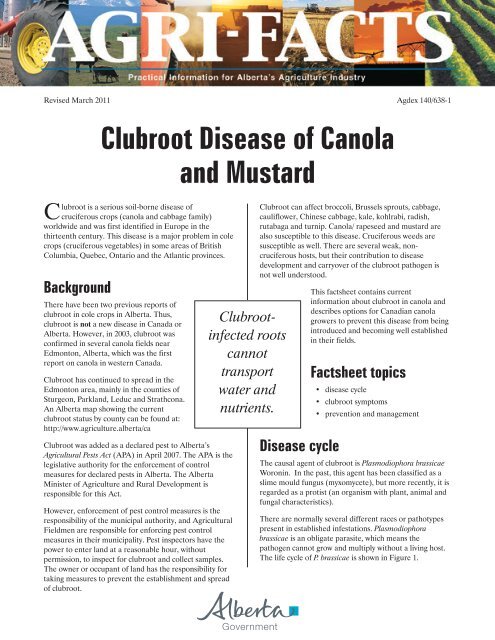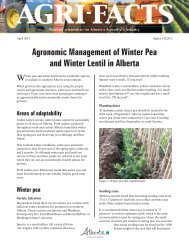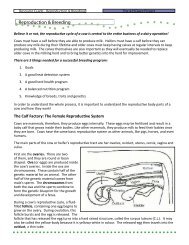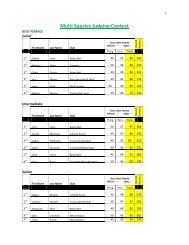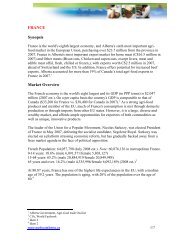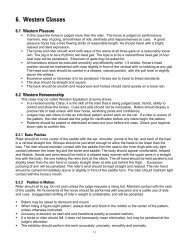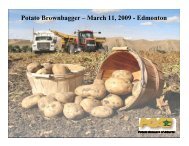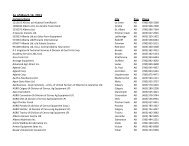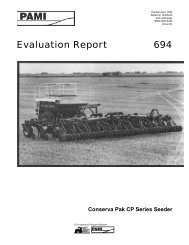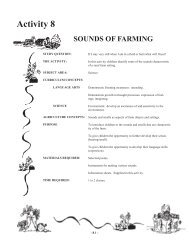Download pdf - Agriculture and Rural Development
Download pdf - Agriculture and Rural Development
Download pdf - Agriculture and Rural Development
You also want an ePaper? Increase the reach of your titles
YUMPU automatically turns print PDFs into web optimized ePapers that Google loves.
Revised March 2011 Agdex 140/638-1Clubroot Disease of Canola<strong>and</strong> MustardClubroot is a serious soil-borne disease ofcruciferous crops (canola <strong>and</strong> cabbage family)worldwide <strong>and</strong> was first identified in Europe in thethirteenth century. This disease is a major problem in colecrops (cruciferous vegetables) in some areas of BritishColumbia, Quebec, Ontario <strong>and</strong> the Atlantic provinces.BackgroundThere have been two previous reports ofclubroot in cole crops in Alberta. Thus,clubroot is not a new disease in Canada orAlberta. However, in 2003, clubroot wasconfirmed in several canola fields nearEdmonton, Alberta, which was the firstreport on canola in western Canada.Clubroot has continued to spread in theEdmonton area, mainly in the counties ofSturgeon, Parkl<strong>and</strong>, Leduc <strong>and</strong> Strathcona.An Alberta map showing the currentclubroot status by county can be found at:http://www.agriculture.alberta/caClubroot was added as a declared pest to Alberta’sAgricultural Pests Act (APA) in April 2007. The APA is thelegislative authority for the enforcement of controlmeasures for declared pests in Alberta. The AlbertaMinister of <strong>Agriculture</strong> <strong>and</strong> <strong>Rural</strong> <strong>Development</strong> isresponsible for this Act.However, enforcement of pest control measures is theresponsibility of the municipal authority, <strong>and</strong> AgriculturalFieldmen are responsible for enforcing pest controlmeasures in their municipality. Pest inspectors have thepower to enter l<strong>and</strong> at a reasonable hour, withoutpermission, to inspect for clubroot <strong>and</strong> collect samples.The owner or occupant of l<strong>and</strong> has the responsibility fortaking measures to prevent the establishment <strong>and</strong> spreadof clubroot.Clubrootinfectedrootscannottransportwater <strong>and</strong>nutrients.Clubroot can affect broccoli, Brussels sprouts, cabbage,cauliflower, Chinese cabbage, kale, kohlrabi, radish,rutabaga <strong>and</strong> turnip. Canola/ rapeseed <strong>and</strong> mustard arealso susceptible to this disease. Cruciferous weeds aresusceptible as well. There are several weak, noncruciferoushosts, but their contribution to diseasedevelopment <strong>and</strong> carryover of the clubroot pathogen isnot well understood.Disease cycleThis factsheet contains currentinformation about clubroot in canola <strong>and</strong>describes options for Canadian canolagrowers to prevent this disease from beingintroduced <strong>and</strong> becoming well establishedin their fields.Factsheet topics• disease cycle• clubroot symptoms• prevention <strong>and</strong> managementThe causal agent of clubroot is Plasmodiophora brassicaeWoronin. In the past, this agent has been classified as aslime mould fungus (myxomycete), but more recently, it isregarded as a protist (an organism with plant, animal <strong>and</strong>fungal characteristics).There are normally several different races or pathotypespresent in established infestations. Plasmodiophorabrassicae is an obligate parasite, which means thepathogen cannot grow <strong>and</strong> multiply without a living host.The life cycle of P. brassicae is shown in Figure 1.
Kelly TurkingtonFigure 2. Very severe clubroot on canola.Figure 1. Life cycle of Plasmodiophora brassicae, thepathogen that causes clubroot.(Source: Ohio State University).Resting spores germinate in the spring, producingzoospores that swim very short distances in soil water toroot hairs. These resting spores are extremely long lived,with a half-life of about 4 years, but they can survive insoil for up to 20 years. For example, Swedish research inclubroot-infested spring rapeseed fields found that17 years were needed to reduce the infestation tonon-detectable limits.The longevity of the resting spores is a key factorcontributing to the seriousness of the disease. Restingspore germination is stimulated by exudates from theroots of host plants.After the initial infection through root hairs or wounds,the pathogen forms an amoeba-like cell. This unusual cellmultiplies <strong>and</strong> then joins with others to form aplasmodium, which is a naked mass of protoplasm withmany nuclei. The plasmodium eventually divides to formmany secondary zoospores that are released into the soil.These second-generation zoospores re-infect roots of theinitial host or nearby plants <strong>and</strong> are able to invade thecortex (interior) of the root. Once in the cortex, theamoeba-like cells multiply or join with others to form asecondary plasmodium. As this plasmodium develops,plant hormones are altered, which causes the infectedcortical cells to swell. Clusters of these enlarged cells form“clubs” or galls (see Figures 2, 3 <strong>and</strong> 4).Figure 3. Severe clubroot galls or “clubs” on canola root.Figure 4. Moderately infected canola root.Some amoeba-like cells are able to move up <strong>and</strong> downroots in vascular tissue. After the secondary plasmodiamature, they divide into many resting spores within thegall tissue. The galls are quickly decayed by soil microbes,leaving millions of resting spores in the soil.Kelly TurkingtonValerie Sowiak2
Although there are no airborne spores released by thispathogen, the resting spores are capable of moving withinfested soil transported by wind or water erosion <strong>and</strong>field machinery.Warm soil (20-24°C), high soil moisture <strong>and</strong> acid soil(pH less than 6.5) are environmental factors that favourinfection <strong>and</strong> severe disease development. Unfortunately,these conditions exist in a significant portion of thetraditional canola growing areas of Alberta.High soil moisture areas of the field typically have themost severe infestations. These wet areas are found indepressions, spots with higher clay content or with subsoilhorizons that cause poor water infiltration (such asGray Wooded or solonetzic soils).Clubroot symptoms on canola<strong>and</strong> mustardClubroot galls are a nutrient sink, so they tie up nutrients,<strong>and</strong> severely infected roots of canola cannot transportsufficient water <strong>and</strong> nutrients for aboveground plant parts.Symptoms will vary depending on the growth stage of thecrop when infection occurs. Early infection at the seedlingstage can result in wilting, stunting <strong>and</strong> yellowing ofcanola plants in the late rosette to early podding stage.Such symptoms may be wrongly attributed to heat stressduring periods with high temperatures or to other diseasessuch as blackleg or Fusarium wilt. In such cases, properdiagnosis includes digging up wilted plants to check forgall formation on roots.Figure 5. Patchy, premature ripening.If the suspected plants are not sampled until afterswathing, root galls may have decayed already, <strong>and</strong> thetypical whitish galls will no longer be present (seeFigure 6). Instead, decayed root galls have a brown peatyappearance rather than the healthy white colour ofunaffected root tissue, which should be a signal tocarefully dig up more roots for closer inspection.Stephen StrelkovInfection that occurs at later stages may not show plantwilting, stunting or yellowing. However, infected plantswill ripen prematurely, <strong>and</strong> seeds will shrivel. Thus, yield<strong>and</strong> quality (oil content) are reduced.Swedish researchers found that infestations nearing100 per cent-affected plants caused about 50 per centyield loss, while infestations of 10 to 20 per cent led to5 to 10 per cent yield loss. This result is similar tosclerotinia stem rot infection in canola, where a generalrule of thumb yield loss estimate is half of the percentageof infected stems. This is a reasonable comparison sinceboth diseases restrict the flow of water <strong>and</strong> nutrients todeveloping seeds.Patches of prematurely ripening canola due to clubrootinfection (Figure 5) could be confused with other diseasessuch as sclerotinia, blackleg <strong>and</strong> Fusarium wilt. In suchcases, proper diagnosis should include digging up affectedplants to check for gall formation on roots. Swathing is anexcellent opportunity to spot clubroot infestations.Figure 6. Decayed clubroot galls <strong>and</strong> whitish stemappearance.Hybridization nodules on canola roots (see Figure 7),although rare, could be confused with clubroot galls, butthey appear as small, round nodules located at root nodes.The interior texture of a clubroot gall is spongy ormarbled while hybridization nodules are uniformly denseinside, like healthy roots. Furthermore, hybridizationnodules will not decay rapidly <strong>and</strong> do not have a peatyappearance like clubroot galls do.Kelly Turkington3
Prevention <strong>and</strong> management ofclubroot in canola <strong>and</strong> mustardSince clubroot infestations are still not widely distributedin Alberta, producers should take various precautionarymeasures to curb the spread of this disease outside theknown infested areas.Figure 7. Hybridization nodules on canola root.Phenoxy damage to canola may also induce galls on stembases <strong>and</strong> roots (Figure 8). As with hybridization nodules,the phenoxy-induced galls will not decay rapidly likeclubroot galls. Thickened, corky or split stem bases <strong>and</strong>curving stems are additional phenoxy symptoms that oftenoccur in canola.Figure 8. Root galls on canola due to phenoxy injury.For confirmation of suspected canola clubroot galls, sendsamples to one of the commercial seed testing labs in theprovince.Alvin EyolfsonPreventionRecommended preventative measures include thefollowing:• Use long rotations – grow canola not more frequentlythan once every four years (i.e. three years out ofcanola). Although this practice will not prevent theintroduction of clubroot to clean fields, it will restrictthis <strong>and</strong> other canola disease development within thefield <strong>and</strong> probably avert a severe infestation. Thisrotation recommendation is similar to Europe whereclubroot is more established, <strong>and</strong>, thus, moreexperience has been gained in management of thisdisease (see the Scottish clubroot factsheet by S. Oxley,2007, noted in the References section at the end of thisfactsheet).• Planting clubroot-resistant varieties on fields withoutthe disease can be useful when clubroot is presentnearby. This strategy relies on the genetic resistance togreatly reduce disease development/establishmentcompared to susceptible varieties if clubroot isinadvertently introduced to the field.• Practice good sanitation to restrict the movement ofpossibly contaminated material (this approach will helpreduce the spread of other diseases, weeds <strong>and</strong> insectstoo). The resting spores are most likely to spread viacontaminated soil <strong>and</strong> infected canola plant parts.Thus, producers should follow the practice of cleaningsoil <strong>and</strong> crop debris from field equipment beforeentering or leaving all fields. The equipment cleaningprocedure involves knocking or scraping off soil lumps<strong>and</strong> sweeping off loose soil.For risk-averse producers, the following additionalcleaning steps may provide some extra benefit butinvolve considerably more work <strong>and</strong> expense:• after removal of soil lumps, wash off equipment witha power washer, preferably with hot water or steam• finish by misting equipment with weak disinfectant(1-2% household bleach solution)• Use direct seeding <strong>and</strong> other soil conservation practicesto reduce erosion. Resting spores move readily in soiltransported by wind or water erosion <strong>and</strong> overl<strong>and</strong>flow.4
• Scout canola fields regularly <strong>and</strong> carefully. Identifycauses of wilting, stunting, yellowing <strong>and</strong> prematureripening – do not assume anything!• Avoid the use of straw bales <strong>and</strong> manure from infestedor suspicious areas. Clubroot spores are reported tosurvive through the digestive tracts of livestock.• Avoid common untreated seed (including canola,cereals <strong>and</strong> pulses). Earth-tag on seed from infestedfields could introduce resting spores to clean fields.Certain seed treatment fungicides may control sporeson contaminated seed, but this observation needsfurther research to confirm.Note: the risk of spreading clubroot by contaminated seedor straw is much lower than by the transportation of soil<strong>and</strong> plant debris on contaminated field equipment.ManagementManaging clubroot after establishment in a canola field isdifficult <strong>and</strong> long term.There are clubroot-resistant Canadian canola varietiesavailable now. However, the clubroot resistance inEuropean varieties has not been durable there, <strong>and</strong> thus,we should expect a similar breakdown in western Canada.Resistance breakdown is not a change in the plant, butrather in the clubroot pathogen where it adapts to theresistance in the varieties being grown. There are severalprevalent clubroot race(s) or pathotypes in the Albertainfestations, with one pathotype dominating. However,characterization of single spore-derived isolates from thepopulations indicates there are additional pathotypes <strong>and</strong>mixtures of pathotypes.To prolong the effectiveness of clubroot resistance,producers should not plant resistant varieties more thanonce every four years – this practice is similar to Scottishrecommendations mentioned above.Clubroot galls may still be found at low levels in fieldsseeded to resistant varieties! Under high pressure, smallgalls may develop on plants with clubroot resistance. Gallscan also occur on volunteers from previous canola cropsof susceptible varieties, mustard family weed species <strong>and</strong>in the small percentage of off-types in hybrid seed (usuallynon-hybrid parental lines where one parental line may beclubroot susceptible).Currently, there are no registered fungicides for clubrootcontrol or suppression in canola. Although there arefungicides registered for clubroot control in cole cropsaround the world, the relatively high cost <strong>and</strong> applicationmethod (transplant bed drench or broadcastincorporation) make them unsuitable for canola fieldproduction.Liming acid soils to above pH 7.2 has shown poor orerratic results for clubroot control in cole crops in BritishColumbia <strong>and</strong> eastern Canada. Given the inconsistency<strong>and</strong> high cost, liming is not a reliable option for clubrootcontrol in canola.Calcium cyanamide, an old form of nitrogen fertilizer withfungicidal properties, has shown promise for reducingclubroot in cole crops, but high application rates,significant cost <strong>and</strong> limited availability make it a pooroption for canola.Volunteer canola <strong>and</strong> susceptible weeds (mustard family,dock <strong>and</strong> hoary cress) must be controlled in the rotationcrops. There is some evidence that a few non-cruciferouscrops such as orchardgrass <strong>and</strong> red clover may be weakhosts for clubroot disease, but the rotational effect of suchcrops on clubroot incidence <strong>and</strong> severity is likely of littlepractical significance.In combination with the rotation strategy, sanitation <strong>and</strong>soil conservation measures should be practiced to keepcontaminated soil <strong>and</strong> infected crop debris from beingtransported from infested fields. Whenever practical,infested fields should not be worked in when wet sincemore mud will stick to equipment <strong>and</strong> then be transportedto clean fields.There has been one report from Norway of lower clubrootseverity under reduced tillage. Thus, reduced tillage ordirect seeding may help to combat a clubroot infestation,<strong>and</strong> the fewer tillage operations will help to avoid thetransport of contaminated soil. Similarly, all equipmenttraffic into infested fields should be minimized – forexample, service <strong>and</strong> nurse trucks should remain on theroad <strong>and</strong> field equipment be brought to them.Clubroot disease is a serious concern in Alberta.Underst<strong>and</strong>ing the disease cycle, recognizing thesymptoms <strong>and</strong> adopting good prevention <strong>and</strong> managementpractices can assist in its control.ReferencesCao, T., Tewari, J.P., <strong>and</strong> Strelkov, S.E. 2007. Moleculardetection of Plasmodiophora brassicae, causal agent ofclubroot of crucifers, in plant <strong>and</strong> soil. Plant Dis. 91:80-87.Ekeberg, E. <strong>and</strong> Riley, H.C.F. 1997. Tillage intensityeffects on soil properties <strong>and</strong> crop yields in a long-termtrial on morainic loam soil in southeast Norway. Soil &Tillage Res. 42: 277-293.Friberg, H., Lagerlof, J., <strong>and</strong> Ramert, B. 2006. Usefulnessof nonhost plants in managing Plasmodiophora brassicae.Plant Pathol. 55:690-695.5
McDonald, M.R., Kornatowska, B. <strong>and</strong> McKeown, A.W.2002. Management of clubroot of Asian Brassica cropsgrown on organic soils. Abstract S08-0-11, XXVI thInternational Horticulture Congress, Toronto.Oxley, S. 2007. Clubroot disease of oilseed rape <strong>and</strong> otherbrassica crops. Technical Note 602. Scottish AgriculturalCollege. Accessed on-line October 5, 2010.http://www.sac.ac.uk/mainrep/<strong>pdf</strong>s/tn602clubroot.<strong>pdf</strong>Strelkov, S.E., Tewari, J.P., <strong>and</strong> Smith-Degenhardt, E.2006. Characterization of Plasmodiophora brassicaepopulations from Alberta, Canada. Can. J. Plant Pathol.28:467-474.Tewari, J.P., Strelkov, S. E., Orchard, D., Hartman, M.,Lange, R., <strong>and</strong> Turkington, T.K. 2005. Identification ofclubroot of crucifers on canola (Brassica napus) inAlberta. Can. J. Plant Pathol. 27:143-144.Tremblay, N., Bélec, C., Lawrence, H., <strong>and</strong> Carisse, O.1999. Clubroot of crucifers – control strategies.<strong>Agriculture</strong> <strong>and</strong> Agri-Food Canada. Saint-Jean-surRichelieu, PQ. 3 pp.Wallenhammar, A.C. 1996. Prevalence of Plasmodiophorabrassicae in a spring oilseed rape growing area in centralSweden <strong>and</strong> factors influencing soil infestation levels.Plant Pathol. 45:710-719.Wallenhammar, A.C., Johnsson, L., <strong>and</strong> Gerhardson, B.1999. Clubroot resistance <strong>and</strong> yield loss in spring oilseedturnip rape <strong>and</strong> spring oilseed rape. Proceedings of 10 thInternational Rapeseed Congress, Australia.Prepared byMurray Hartman, Oilseed Specialist,<strong>Agriculture</strong> <strong>and</strong> <strong>Rural</strong> <strong>Development</strong>With contributions from the following plant pathologists:J.P. Tewari, Kelly Turkington, Ralph Lange, StephenStrelkov, Ron Howard <strong>and</strong> Paul LaflammeFor more informationAlberta Ag-Info CentreCall toll free: 310-FARM (3276)Website: www.agriculture.alberta.caRP06/13/5M6


